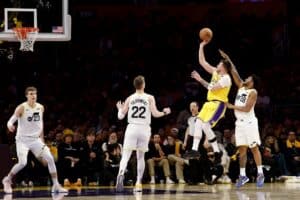Though half-game bets are growing in popularity at the top-rated sportsbooks, most basketball bettors prefer making full-game bets because they feel they have a better understanding of the ebbs and flows of an NBA contest, be it against the spread or for totals.
Advantage bettors seeking a more definitive edge will also add selective first-half wagering or second-half bets when positioned to bounce on certain numbers. Here are betting tips to focus on that can build your bankroll when stepping out of the norm.
Betting NBA First Half Sides
After a dozen games are played in the NBA’s season, teams have played home and road enough to develop a few notable patterns to follow.
A good veteran team as a double-digit favorite might be inclined to a slower start, knowing they can ultimately win, waiting to “turn it on” when needed in the second half. This could be an opportunity to bet against the favorite. This is further enhanced as most first-half lines go toward the favorite, so a 10-point game fave is often -5.5 or -6 on the first-half line.
Here is another situation. The NBA schedule is something every bettor has to consider daily. When making a two quarters wager, if a favorite or underdog played last night and is on the road and takes on the home team with a couple of days off, the home club might have more early energy to beat the spread.
Increasingly, there are websites that track quarter-by-quarter or first and second-half numbers for all 30 teams so you can be more informed about how the various teams perform in different scenarios and follow their tendencies.
Betting First-Half Totals
The general concept is the same as spread betting, but totals have their idiosyncrasies.
Not that many years ago, NBA totals were determined by taking the full game total and dividing by two and that’s how the oddsmakers arrived at a first-half figure. Today, the amount of information permits the new sportsbooks to better hone in on team info and create more accurate numbers.
One first-half total trend to look for is teams on road trips of four or more contests or playing a similar period of home games. After three games of either case, you might spot they come out of the gate fast or be slow starters, and if matched with an opponent who has recently played the same way, you can find an Over or Under that aligns with the numbers.
Betting NBA Second Half Sides
The first aspect of second-half wagering is knowing what to look for and creating a process that works for how you like to wager. To just bet on an NBA favorite of say -10 for the game that trails at halftime by five points is an ordinary strategy the sharp bookmaker expects basketball bettors to make.
Instead, if you have never bet on second halves take a half-season (or longer) to get a feel for what you are looking at and learn. NBA halftimes are 15 minutes, so oddsmakers have a short time to make decisions and so do you, the difference is they have the edge, setting these numbers every night, often for years.
In the above scenario, a linemaker comprehends most bettors will expect the favorite to have a big second half and will shade the number against that team which is trending 15 points below the full game line for the favorite. Instead of a -9 or -10 on the fave, they might post a -12 to suck the bettor into a weaker number. That doesn’t mean the underdog is the right side either, but it offers more value.
Hot Streaks or Mental Breaks?
What’s important to understand is how the first half score arrived at its score. Did the underdog have a hot-shooting first half, drain far more three-pointers than usual or the favored club was a mental no-show and commit 10 turnovers in a half? Knowing this and having the awareness of will both teams play back to normal or if the underdog is in current strong form in their last five games and can likely keep it up for another half? That’s where the skill comes in learning the craft.
One other note, in studying these bets, simplify the process bet in a time window conducive for you to follow. East Coasters might want to limit themselves to games in the 7:00 window, while those on the other coast would do the same in their 7:00 pm time slot to give you the most freedom to make your best decisions.
Betting second half totals is nearly identical to sides; you just need to know the shooting numbers and what the pace of the contest is. Unless you bet mostly totals, it’s probably best to pass on totals after halftime because of time constraints.
In conclusion, there are many ways to earn more of a profit other than betting on full games and the best way to do so is to learn the ins and outs and become an expert. Who knows, maybe you will find out all the volatility can be taken out by just betting half a game, which makes you more money.









